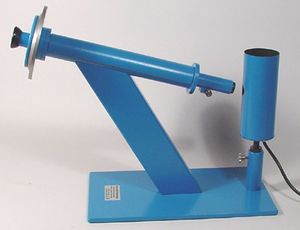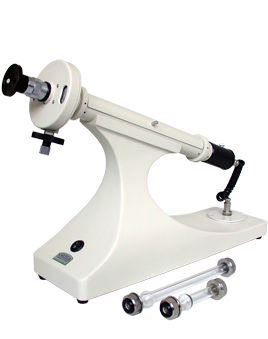Polarimeters
Polarimeter is a scientific instrument used to measure the angle of rotation caused by passing polarized light through an optically active substance.Some chemical substances are optically active, and polarized (unidirectional) light will rotate either to the left (counter-clockwise) or right (clockwise) when passed through these substances. The amount by which the light is rotated is known as the angle of rotation.
Polarization by reflection was discovered in 1808 by Etienne-Louis Malus (1775–1812).
Construction
The polarimeter is made up of two Nicol prisms ,the polarizer and analyzer). The polarizer is fixed and the analyzer can be rotated. The prisms may be compared to as slits S1 and S2. The light waves may be considered to correspond to waves in the string. The polarizer S1 allows only those light waves which move in a single plane. This causes the light to become plane polarized. When the analyzer is also placed in a similar position it allows the light waves coming from the polarizer to pass through it. When it is rotated through the right angle no waves can pass through the right angle and the field appears to be dark. If now a glass tube containing an optically active solution is placed between the polarizer and analyzer the light now rotates through the plane of polarization through a certain angle, the analyzer will have to be rotated in same angle.
Operation
Polarimeters measure this by passing monochromatic light through the first of two polarising plates, creating a polarized beam. This first plate is known as the polarizer.This beam is then rotated as it passes through the sample. The sample is usually prepared as a tube where the optically active substance is dissolved in an optically inactive chemical such as distilled water,ethanol, methanol. Some polarimeters can be fitted with tubes that allow for sample to flow through continuously. After passing through the sample, a second polarizer, known as the analyzer, rotates either via manual rotation or automatic detection of the angle. When the analyzer is rotated to the proper angle, the maximum amount of light will pass through and shine onto a detector.
Applications
Because many optically active chemicals such as sucrose, are stereoisomers, a polarimeter can be used to identify which isomer is present in a sample – if it rotates polarized light to the left, it is a levo-isomer, and to the right, a dextro-isomer. It can also be used to measure the ratio of enantiomers in solutions.
Chemical industry
Many chemicals exhibit a specific rotation as a unique property which can be used to distinguish it. Polarimeters can identify unknown samples based on this if other variables such as concentration and length of sample cell length are controlled or at least known. This is used in the chemical industry.By the same token, if the specific rotation of a sample is already known, then the concentration and/or purity of a solution containing it can be calculated.Most automatic polarimeters make this calculation automatically, given input on variables from the user.
Food, beverage and pharmaceutical industries
Concentration and purity measurements are especially important to determine product or ingredient quality in the food and beverage and pharmaceutical industries. Samples that display specific rotations that can be calculated for purity with a polarimeter include:
- Steroids
- Diuretics
- Antibiotics
- Narcotics
- Vitamins
- Analgesics
- Amino Acids
- Essential Oils
- Polymers
- Starches
- Sugars
Polarimeters are used in the sugar industry for determining quality of both juice from sugar cane and the refined sucrose. Often, the sugar refineries use a modified polarimeter with a flow cell called a saccharimeter.

